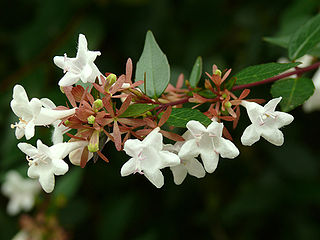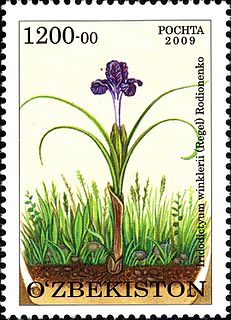
The Caprifoliaceae or honeysuckle family is a clade of dicotyledonous flowering plants consisting of about 860 species in 42 genera, with a nearly cosmopolitan distribution. Centres of diversity are found in eastern North America and eastern Asia, while they are absent in tropical and southern Africa.

Abelia is a formerly recognized genus that contained about 30 species and hybrids, placed in the honeysuckle family, Caprifoliaceae. Molecular phylogenetic studies showed that the genus was not monophyletic, and in 2013, Maarten Christenhusz proposed the merger of Abelia into Linnaea, along with some other genera. Abelia section Zabelia was raised to the genus Zabelia.

Lactuca, commonly known as lettuce, is a genus of flowering plants in the daisy family, Asteraceae. The genus includes at least 50 species, distributed worldwide, but mainly in temperate Eurasia.

Linnaea × grandiflora, synonym Abelia × grandiflora, is a hybrid species of flowering plant in the honeysuckle family Caprifoliaceae, raised by hybridising L. chinensis with L. uniflora.

Malus sieversii is a wild apple native to the mountains of Central Asia in southern Kazakhstan. It has recently been shown to be the primary ancestor of most cultivars of the domesticated apple. It was first described in 1833 by Carl Friedrich von Ledebour, a German naturalist who saw them growing in the Altai Mountains.

Hakea corymbosa, commonly known as the cauliflower hakea is a plant of the family Proteaceae which is endemic to the south-west of Western Australia. An attractive extremely prickly bush with sweetly scented yellowish flowers. The nectar rich blooms and dense form provides a good habitat for wildlife.

Allium giganteum, common name giant onion, is an Asian species of onion, native to central and southwestern Asia but cultivated in many countries as a flowering garden plant. It is the tallest species of Allium in common cultivation, growing to 1.5 metres (4.9 ft).

Linnaea is a plant genus in the family Caprifoliaceae. Until 2013, the genus included a single species, Linnaea borealis. In 2013, on the basis of molecular phylogenetic evidence, the genus was expanded to include species formerly placed in Abelia, Diabelia, Dipelta, Kolkwitzia and Vesalea. However, this is rejected by the majority of subsequent scientific literature and flora.
Maranthes corymbosa is a tree in the family Chrysobalanaceae. The specific epithet corymbosa is from the Greek meaning "cluster", referring to the clustered inflorescences.

Eremurus is a genus of deciduous perennial flowers, also known as the foxtail lilies or desert candles. They are native to eastern Europe and temperate Asia from Turkey + Siberia to China.
Trichanthemis is a genus of Central Asian plants in the chamomile tribe within the daisy family.

Fallopia baldschuanica is an Asian species of flowering plant in the knotweed family known by several common names, including Russian-vine, Bukhara fleeceflower, Chinese fleecevine, mile-a-minute and silver lace vine. It is native to Asia, and it can be found growing wild in parts of Europe and North and Central America as an introduced species.

Zabelia tyaihyonii, synonym Abelia mosanensis, known as the fragrant abelia, is a species of deciduous shrub in the honeysuckle family Caprifoliaceae. Growing up to 2 meters high and wide, it is hardier than many related species, surviving temperatures as low as −20 °C (−4 °F). The tubular blooms are pinkish-white and highly scented, appearing in late Spring. The glossy green leaves turn red in autumn before falling.

Linnaea parvifolia, synonym Abelia schumannii, is a species of flowering plant in the family Caprifoliaceae, native to central China. It is a semi-evergreen shrub growing to 2 m (7 ft) tall by 3 m (10 ft) broad. Pink flowers with red calyces are produced in late summer and autumn.

Iris kolpakowskiana, or Kolpakowski's iris, is a plant species in the genus Iris, it is classified in the subgenus Hermodactyloides and section Monolepsis. It is a bulbous perennial from Asia.

Iris winkleri, or Winkler iris, is a species in the genus Iris, classified in the subgenus Hermodactyloides and section Monolepsis. It is a bulbous perennial from Turkestan, in Central Asia.
Iris darwasica is a plant species in the genus Iris, it is also in the subgenus Iris and in the section Regelia. It is a rhizomatous perennial, from Tajikistan and northern Afghanistan. It has long and thin glaucous to grey-green leaves, slender stem and greenish cream or greenish yellow, to dark purple or lilac flowers.
Iris lineata is a plant species in the genus Iris, it is also in the subgenus Iris, and in the section Regelia. It is a rhizomatous perennial, from the mountains of Turkestan, between Tajikistan and Afghanistan. It has tall slender stems, long leaves and greenish yellow flowers covered, with brown violet, or brown purple veining over the top. It is cultivated as an ornamental plant in temperate regions.

The taxonomy of Tulipa places the genus in the family Liliaceae, and subdivides it as four subgenera, and comprises about 75 species.

Zabelia is a genus of flowering plant in the family Caprifoliaceae.
















